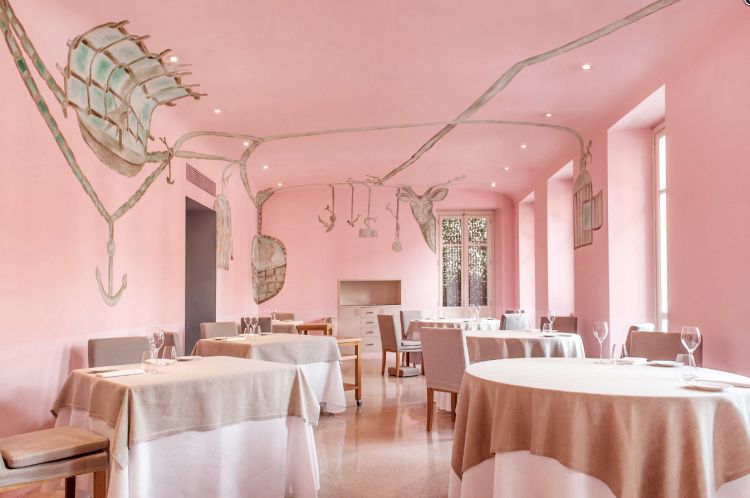This story starts at the end, or rather, from a sentence told at the end of a very high-level lunch: ‘Many workers in various companies have benefits. Time has taught me that, for us in this profession, the greatest benefit is one: creating relationships.’ These are the words of Davide Franco, restaurant manager at Piazza Duomo in Alba, a name that certainly doesn’t need much description.
So now, like a kind of flashback, let us rewind the tape and catapult ourselves to the beginning of the story of this experience. In the heart of Piedmont, in a town kissed by hazelnuts, vineyards and white truffles, the Ceretto family wanted to dedicate a corner of Piazza Duomo to two restaurants (there is also La Piola). Enrico Crippa has always been the mainstay of this system of taste: an unmistakable dining style is based on him, amplified by the dining room service, which until recently was the prerogative of Vincenzo Donatiello. In February 2022, a small revolution took place: Donatiello flew to other eastern shores, while Davide Franco and Jacopo Dosio arrived in Alba, respectively, as restaurant manager and wine director. Both young but with precious experience, they immediately decoded Crippa's style, transposing it into one of the most delicate dining room services. This is how the relationships that director Franco mentioned earlier are born, with the help of a smile, an anecdote, a sip of Dosio's wines (capable of catapulting the guest to the Canary Islands, for example, at Akaet’s a tiny producer he visited) or a well-crafted explanation of the dishes, which vary even more often, thanks to the Seasonal Things menu.

Davide Franco and Jacopo Dosio
This proposal results from Crippa's desire to be more and more in synergy with the fruits of the now legendary
Piazza Duomo vegetable garden (now exceeding 3 hectares), linking these fruits to the rest of the ingredients, obviously without any waste. This is how you can taste the evergreen
Insalata 21, 31, 41, 51, which has more than a hundred elements even in winter, or a spinach that is so tasty that it stands up to the sea bass it is paired with, or even a pak-choi (Chinese cabbage) between chlorophyll and floral. At first glance, one is almost stunned by the visual beauty of the elements on the plate. One could practically stop there in contemplation. But then instinct takes over, tickling the palate, and then... you taste it, revealing a complexity that is as unexpected as easily assimilated.
One would almost have to bother the Accademia della Crusca to rewrite the definition of 'incredible' in a palatal key. It is incredible how balanced and well-marinated the ingredients are, even though the sauces are 'significant' and complex, but in an intelligent way, thanks to Enrico Crippa's witty expertise, which always and in any case puts the quality of the raw material at the centre and takes everything on the plate by the hand, like the true chef, master, genius and artist he is. Never equal to itself, the hand of this brigade moves between Italy, France, Japan and the whole of the East, always with a trace of Mr Marchesi (the risotto is mantecato with sour butter and Parmigiano and served with cardamom: less is more).Being cosmopolitan recalls travel, which often embraces art, not least because of the same idea of freedom that these two things exude. In addition to the celebrated Panna cotta Matisse, today Chef Crippa pays homage to Antoni Gaudì and Anselm Kiefer with two dishes that are antithetical in colour (the former glittering, the latter in black, white and sepia) but equally enthralling in flavour and form.

Another feature that makes the food unique is the dance of coloured plates, saucers and bowls (the latter specially made for
Piazza Duomo), which, orchestrated by the dining brigade almost like a metronome, does justice to the so-called side dishes. Here, they act as true and indispensable amplifiers of the main dish, with the peculiarity that they are often broths of all kinds (cod, duck, prawns...) or vegetables (mushrooms, quince or many others), seasoned like the main dish.
There is a further occasion to reflect on the sustainability of the ingredients, thanks to a bread predessert, to a dessert made with fruit jellies and quince or to tacos made with meliga. This flour has always been abundant in Piedmont. The last step of this journey is made of icons, such as Hazelnut cake and Latte +, almost as if to take the guest back there, to Alba, in the dining room with the unmistakable pink walls. Piazza Duomo is more alive than ever. Indeed, it is also vivid, like the colours that mark this place, first in the people and then on and off the plates.
Our tasting
- The aperitif is made up of a series of Crippa classics: mock olives (the black one hides a langoustine tartare, the green one a veal tartare), Recoaro Gingerino (mousse of bitter, foie gras cream, crispy corn) with peanut wafer and Parmesan Chips, garlic soy mayonnaise, flower, pepper and lemon zest.
- Caviar (the dishes’ names are made of only one word, leaving guests amazed at the multitude of elements that often make them up): Lettuce heart napped with meat stock, a base of curdled milk, caviar, marinated egg yolk, lemon. Fried squid ink krapfen, filled with sour cream and caviar on top. Caviar eye: cuttlefish ink puff pastry, sour cream and caviar. Cod consommé. It was a very elegant start, of rare balance, as well as the frying of the very light krapfen.
- Takoyaki: meatball stuffed with prawns, furikake and okonomiyaki sauce. Salted crème caramel with miso reduction. Mushroom broth. There’s space for indulgence here...
- Salad 21, 31, 41, 51...: it is one of the true symbols of the restaurant, a revolutionary dish. It includes up to 127 elements in summer but exceeds 100 elements in winter. It’s made of two parts: from top to bottom, there are the spicier, spicy, bitter elements, then the more delicate ones, seasoned with a dressing of grape seed oil, sesame and Barolo vinegar. There is a tangerine dashi broth to drink at the end—total verticality and all based on a surprising vegetable hegemony.
- Raw spinach and sea bass, mustard sauce and mustard seeds. Brussels sprouts with their leaves, dressed with the same sauce. Almond and fennel chips. The vigorous flavour of the spinach is surprising and holds its own against the raw fish.
- Antoni Gaudí (dedicated to Barcelona and a mosaic by the artist). The dish is based on sauces: marinated yolk sauce, tomato choron sauce, shrimp, hedgehog and orange reduction, cod and parsley sauce, and raw San Remo shrimp. It is completed with shrimp broth and furikake chips. Equally beautiful and good, it’s the epitome of knowing how to take the ingredients by the hand and lead them to lofty heights of taste, even when they’re 'only' prawns and sauces.
- Scallop: it’s cooked in the shell and served with black truffle and a grating of white truffle. Cream of potato, bacon and white truffle. Onion puff pastry. A carousel of heady aromas between sea and land.
- Foie Gras: in escalope, with puntarelle and corn powder. Duck broth. The dish is only seemingly classic, as it is not at all easy to manage the bitterness of the puntarelle without covering the foie gras. Needless to say, Crippa, thanks also to his vegetable garden, has managed it very well. And that duck broth ...
- The bread: corn breadsticks (very crispy: one pulled the other), hazelnut flaky bread (slightly sweet), and ciabatta made with sourdough. You can notice an increased sprint in the bakery compared to a few years ago.
- Kiefer Cuttlefish (dedicated to Anselm Kiefer, an artist whose work is exhibited at Piazza Duomo): cuttlefish puff covered with a cream of thistle, anchovy sauce, cuttlefish ink. White polenta with the same sauce. Apart from the great exercise in technique, one should emphasise the antithesis between the colours (white, black and cuttlefish) and the full, but very well-centred flavours. A masterpiece echoing another masterpiece.
- Grilled Sole, pak-choi, rocket and pumpkin sauce: this is where all the work in the Piazza Duomo vegetable garden comes out, resulting in delicious and flavourful vegetables, like this pak-choi.
- Carnaroli rice (from the tiny producer Greppi in Vercelli) creamed with sour butter, Parmesan cheese and cardamom: an unexpected caress, with cardamom as the real protagonist, on a Marquesan canvas. Four ingredients are enough to make a great first course.
- Tortello filled with mascarpone and nduja, veal broth: a fine homage to southern Italy, with nduja often returning among Crippa's ingredients.
- Lamb (by Michele Varvara), creamy goat's cheese base, curry sauce, fiolaro broccoli. Excellent protein, excellent execution.
- Hare: foie gras cream and cooking sauce; braised hare sphere stuffed with foie gras, glazed with red wine sauce and black truffle. The sphere is worth tasting.
- Bread ice cream, bread crumble, and cinnamon crumble at the base: a great example of an anti-waste recipe, as has been done here for some time now.
- Jellies: chestnut, quince and dried fruit, with orange and persimmon sauce. Cocoa leaf, tart filled with quince jam, hot quince consommé. What a great idea to offer a dessert with jellies: a bold, stimulating, and satisfying move.
- Meliga Tacos, Chantilly cream, corn powder, strawberry grape puree. Barolo Chinato sorbet. The conclusion is linear, not at all cloying, with the refreshing sorbet that reminds one of the great land of the Langhe.
- Petit fours: Hazelnut cake, Mandarin tangerines, Fragrant crepes with carrot caramel and hazelnut cream, Marshmallow with limoncello cream and lime zest, Date, Milk + (homage to A Clockwork Orange: milk, muscat grappa and vanilla). The closure could only be made of iconic sweets, such as the hazelnut cake and Latte +, by now emblems of Piazza Duomo. The crepe with carrot caramel was also delicious.